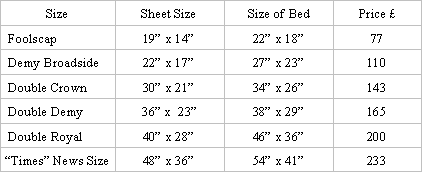|
* * * * * * * * * * * * * * * * * * * * * * * * * * * * * * * * * * * * * * * * * * Early model English Cylinder Press, built on the 'tumbler' principle. The press was named after Thomas Main, a printer who took out a patent for his Main or Tumbler machine in 1850. The peculiarity of the Main consisted of the rocking action of the cylinder which lifted slightly and rolled backwards or 'tumbled' back to the starting position after the impression stroke. It was claimed this action enabled the printed sheets to be delivered more efficiently! He joined with William Conisbee in 1854 but apparently got into financial difficulties shortly thereafter and fled to Australia. (where else!) Conisbee, undeterred, bought out the patent, improved the machine and in 10 years sold some 700 models (unsure whether he continued with the Tumbler principle on later models?).
The advertising states: "It has been specially designed for Fine printing, and is found in practice fully equal to the French Cylindrical Machines for the purpose, while it is equally well adapted (owing to its high speed) to News, Rule, Colour, Broadside, and General Printing. The Cylinder is provided with double machine-cut gear; disconnecting Gear is fitted enabling the Forme to be inked up before proceeding to print; the Table has long traverse, to ensure first-class inking; Patent Pointing Apparatus is provided, to ensure the greatest accuracy in register; and in fact the entire machine is offered as a first-rate specimen of an English Printing Machine, in competition with any machine in its class'. Press speeds were quoted as 1,200 to 1,300 sheets per hour.
These 'pre-flyer' presses required a brave boy to 'fly' the printed sheet from the impression cylinder and place it on the flat table mounted over the inking system, particularly with the cylinder reversing! Note also the lack of guards over the main driving gears! (under the ink fountain)
(Courtesy of Peter Marsh, bookbinder apprentice in 1960 at the MSPGA.)
* * * * * * * * * * * * * * * * * * * * * * * * * * * * * * * * * * * * * * * * * * *
|
|


